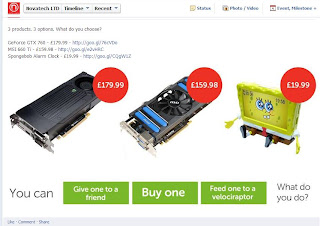“Help, don’t sell; talk, don’t yell; show, don’t tell.”
Two of us look after our company's social media and, inspired by our Do Lectures workshops, we drew up a manifesto to explain how and when we use Facebook and Twitter to our often bemused colleagues. Like all good things, much of it is borrowed from/inspired by others' work. 'If I have seen further... shoulders of giants... etcetera, etcetera'
Rules are of course there to be broken, so they are not set in stone and are easy to break well, but the only utterly unbreakable, inviolable, golden rule is aim four.
Aims:
1.To capture the hearts and minds of the IT managers and directors
of tomorrow
2. To own ‘worry free computing’ on social media – both the
phrase and the sentiment
3. To drive positive brand associations and a wider
understanding of what Novatech really does
4. To be awesome
What we do & why we do it:
1, We will be useful.
We help, inform, inspire and entertain.
Our social media are customer contact and engagement
channels not promotion and sales devices. We will feature and highlight our
best products and services, but PR, Advertising, direct marketing, direct sales
and retail are better sales tools.
2, Meet and greet; don’t sell.
We will build trust by being a friendly and informed first
impression so people can choose to take the next step in the buying cycle.
3, We will let people in.
Reacting quickly and wittily humanises cold digital
exchanges. Showing the people behind the scenes personalises the impersonal and
illustrates our unique ‘all under-one-roof’ integration between departments.
4, We don’t chase a bigger number. To quote someone wiser
“The thing we should be trying to do is to try to make our followers more
engaged with what we are doing. Ultimately, how engaged our followers are will
say more about us than just how many there are.” The number of followers is
less relevant than how they feel when our posts appear in their timeline. RTs,
Shares and follower numbers are a just a base KPI – reputation is all.
5, We don’t overuse it.
“Got something good to say, then say it. Got nothing good to
say, then let’s be comfortable with silence. Like any work tool, continual
overuse can make it blunt.” We have to trust that if we are good, then good
will out. People will share and recommend but it’s very hard to force that
through repetition.
6. We are comfortable with being ourselves.
We use “I” not “we”, to give a persona to ‘people who make
technology work’. The voice of worry free computing is a sharp, bright helpful
tech enthusiast – “If I don’t know the answer I know someone right here who
will…” The personality is a mirror to our customers; the kind of person they
would like to hang out with. Or even who they’d like to be.
Follow the timeless wisdom - always be yourself.
Unless you can be a pirate, then always be a pirate.














